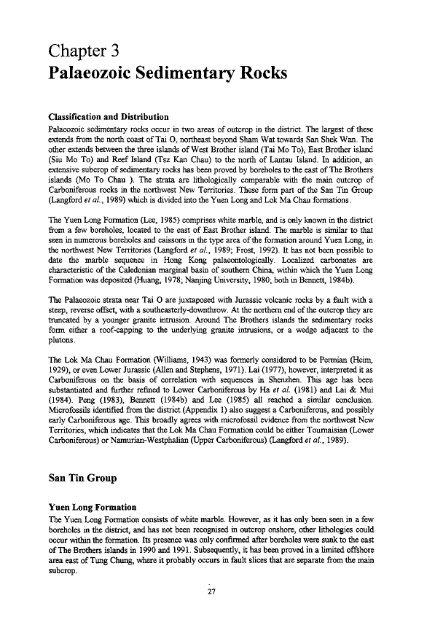1 - HKU Libraries
1 - HKU Libraries
1 - HKU Libraries
Create successful ePaper yourself
Turn your PDF publications into a flip-book with our unique Google optimized e-Paper software.
Chapter 3Palaeozoic Sedimentary RocksClassification and DistributionPalaeozoic sedimentary rocks occur in two areas of outcrop in the district. The largest of theseextends from the north coast of Tai O, northeast beyond Sham Wat towards San Shek Wan. Theother extends between the three islands of West Brother island (Tai Mo To), East Brother island(Siu Mo To) and Reef Island (Tsz Kan Chau) to the north of Lantau Island. In addition, anextensive subcrop of sedimentary rocks has been proved by boreholes to the east of The Brothersislands (Mo To Chau ). The strata are lithologically comparable with the main outcrop ofCarboniferous rocks in the northwest New Territories. These form part of the San Tin Group(Langford et #/., 1989) which is divided into the Yuen Long and Lok Ma Chau formations.The Yuen Long Formation (Lee, 1985) comprises white marble, and is only known in the districtfrom a few boreholes, located to the east of East Brother island. The marble is similar to thatseen in numerous boreholes and caisson's in the type area of the formation around Yuen Long, inthe northwest New Territories (Langford et a/., 1989; Frost, 1992). It has not been possible todate the marble sequence in Hong Kong palaeontologically. Localized carbonates arecharacteristic of the Caledonian marginal basin of southern China, within which the Yuen LongFormation was deposited (Huang, 1978; Nanjing University, 1980; both in Bennett, 1984b).The Palaeozoic strata near Tai 0 are juxtaposed with Jurassic volcanic rocks by a fault with asteep, reverse offset, with a southeasterly-downthrow. At the northern end of the outcrop they aretruncated by a younger granite intrusion. Around The Brothers islands the sedimentary rocksform either a roof-capping to the underlying granite intrusions, or a wedge adjacent to theplutons.The Lok Ma Chau Formation (Williams, 1943) was formerly considered to be Permian (Heim,1929), or even Lower Jurassic (Allen and Stephens, 1971). Lai (1977), however, interpreted it asCarboniferous on the basis of correlation with sequences in Shenzhen, This age has beensubstantiated and further refined to Lower Carboniferous by Ha et al. (1981) and Lai & Mui(1984). Peng (1983), Bennett (1984b) and Lee (1985) all reached a similar conclusion.Microfossils identified from the district (Appendix 1) also suggest a Carboniferous, and possiblyearly Carboniferous age. This broadly agrees with microfossil evidence from the northwest NewTerritories, which indicates that the Lok Ma Chau Formation could be either Tournaisian (LowerCarboniferous) or Namurian-Westphalian (Upper Carboniferous) (Langford et a/., 1989).San Tin GroupYuen Long FormationThe Yuen Long Formation consists of white marble. However, as it has only been seen in a fewboreholes in the district, and has not been recognised in outcrop onshore, other lithologies couldoccur within the formation. Its presence was only confirmed after boreholes were sunk to the eastof The Brothers islands in 1990 and 1991. Subsequently, it has been proved in a limited offshorearea east of Tung Chung, where it probably occurs in fault slices that are separate from the mainsubcrop.27

















